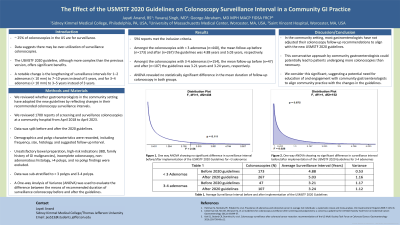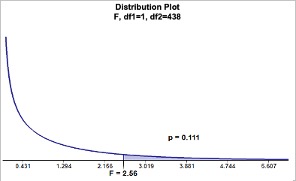Sunday Poster Session
Category: Colorectal Cancer Prevention
P0390 - The Effect of the USMSTF 2020 Guidelines on Colonoscopy Surveillance Interval in a Community GI Practice
Sunday, October 27, 2024
3:30 PM - 7:00 PM ET
Location: Exhibit Hall E

Has Audio
- JA
Jayati Anand, BS
Sidney Kimmel Medical College at Thomas Jefferson University
Philadelphia, PA
Presenting Author(s)
Jayati Anand, BS1, Yuvaraj Singh, MD2, George Abraham, MD, MPH3
1Sidney Kimmel Medical College at Thomas Jefferson University, Philadelphia, PA; 2University of Massachusetts, Worcester, MA; 3Saint Vincent Hospital, Worcester, MA
Introduction: About 25% of colonoscopies performed in the United States are for surveillance, and data suggests there may be over-utilization of surveillance colonoscopies. The USMSTF 2020 guideline, although more complex than the previous version, offers significant benefits. A notable change is the lengthening of surveillance intervals for 1–2 adenomas (< 10 mm) to 7–10 years instead of 5 years, and for 3–4 adenomas (< 10 mm) to 3–5 years instead of 3 years. We reviewed whether gastroenterologists in the community setting have adopted the new guidelines by reflecting changes in their recommended colonoscopy surveillance intervals.
Methods: This retrospective cross-sectional study reviewed 1700 reports of screening and surveillance colonoscopies at a community hospital from April 2018 to April 2023. Data was split before and after the 2020 guidelines. Demographics and polyp characteristics were recorded, including frequency, size, histology, and suggested follow-up interval. Unsatisfactory bowel preparation, high-risk indications (IBD, family history of GI malignancies), incomplete colonoscopy, non-adenomatous histology, >4 polyps, and no polyp findings were excluded. Data was sub-stratified to < 3 polyps and 3-4 polyps. A One-way Analysis of Variance (ANOVA) was used to evaluate the difference between the means of recommended duration of surveillance colonoscopy before and after the guidelines.
Results: A total of 706 reports met the inclusion criteria. The median age was 60, and 44% were female. Amongst 440 colonoscopies with < 3 adenomas, the mean follow-up before (n=107) and after the guidelines (n=173) was 4.88 years and 5.03 years, respectively. Amongst 154 colonoscopies with 3-4 adenomas, the mean follow-up before (n=47) and after the guidelines (n=107) was 3.21 years and 3.24 years, respectively. ANOVA revealed no statistically significant difference in the mean duration of follow-up colonoscopy in both groups.
Discussion: Our study reveals that in the community setting, most gastroenterologists have not adjusted their colonoscopy follow-up recommendations to align with the new USMSTF 2020 guidelines. This conservative approach by community gastroenterologists could potentially lead to patients undergoing more colonoscopies than necessary. We consider this significant, suggesting a potential need for education of and engagement with community gastroenterologists to align community practice with the changes in the guidelines.

Note: The table for this abstract can be viewed in the ePoster Gallery section of the ACG 2024 ePoster Site or in The American Journal of Gastroenterology's abstract supplement issue, both of which will be available starting October 27, 2024.
Disclosures:
Jayati Anand, BS1, Yuvaraj Singh, MD2, George Abraham, MD, MPH3. P0390 - The Effect of the USMSTF 2020 Guidelines on Colonoscopy Surveillance Interval in a Community GI Practice, ACG 2024 Annual Scientific Meeting Abstracts. Philadelphia, PA: American College of Gastroenterology.
1Sidney Kimmel Medical College at Thomas Jefferson University, Philadelphia, PA; 2University of Massachusetts, Worcester, MA; 3Saint Vincent Hospital, Worcester, MA
Introduction: About 25% of colonoscopies performed in the United States are for surveillance, and data suggests there may be over-utilization of surveillance colonoscopies. The USMSTF 2020 guideline, although more complex than the previous version, offers significant benefits. A notable change is the lengthening of surveillance intervals for 1–2 adenomas (< 10 mm) to 7–10 years instead of 5 years, and for 3–4 adenomas (< 10 mm) to 3–5 years instead of 3 years. We reviewed whether gastroenterologists in the community setting have adopted the new guidelines by reflecting changes in their recommended colonoscopy surveillance intervals.
Methods: This retrospective cross-sectional study reviewed 1700 reports of screening and surveillance colonoscopies at a community hospital from April 2018 to April 2023. Data was split before and after the 2020 guidelines. Demographics and polyp characteristics were recorded, including frequency, size, histology, and suggested follow-up interval. Unsatisfactory bowel preparation, high-risk indications (IBD, family history of GI malignancies), incomplete colonoscopy, non-adenomatous histology, >4 polyps, and no polyp findings were excluded. Data was sub-stratified to < 3 polyps and 3-4 polyps. A One-way Analysis of Variance (ANOVA) was used to evaluate the difference between the means of recommended duration of surveillance colonoscopy before and after the guidelines.
Results: A total of 706 reports met the inclusion criteria. The median age was 60, and 44% were female. Amongst 440 colonoscopies with < 3 adenomas, the mean follow-up before (n=107) and after the guidelines (n=173) was 4.88 years and 5.03 years, respectively. Amongst 154 colonoscopies with 3-4 adenomas, the mean follow-up before (n=47) and after the guidelines (n=107) was 3.21 years and 3.24 years, respectively. ANOVA revealed no statistically significant difference in the mean duration of follow-up colonoscopy in both groups.
Discussion: Our study reveals that in the community setting, most gastroenterologists have not adjusted their colonoscopy follow-up recommendations to align with the new USMSTF 2020 guidelines. This conservative approach by community gastroenterologists could potentially lead to patients undergoing more colonoscopies than necessary. We consider this significant, suggesting a potential need for education of and engagement with community gastroenterologists to align community practice with the changes in the guidelines.

Figure: One-way ANOVA (<3 adenomas)
Note: The table for this abstract can be viewed in the ePoster Gallery section of the ACG 2024 ePoster Site or in The American Journal of Gastroenterology's abstract supplement issue, both of which will be available starting October 27, 2024.
Disclosures:
Jayati Anand indicated no relevant financial relationships.
Yuvaraj Singh indicated no relevant financial relationships.
George Abraham indicated no relevant financial relationships.
Jayati Anand, BS1, Yuvaraj Singh, MD2, George Abraham, MD, MPH3. P0390 - The Effect of the USMSTF 2020 Guidelines on Colonoscopy Surveillance Interval in a Community GI Practice, ACG 2024 Annual Scientific Meeting Abstracts. Philadelphia, PA: American College of Gastroenterology.
